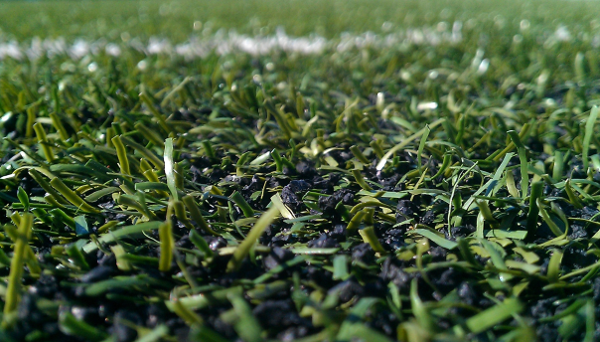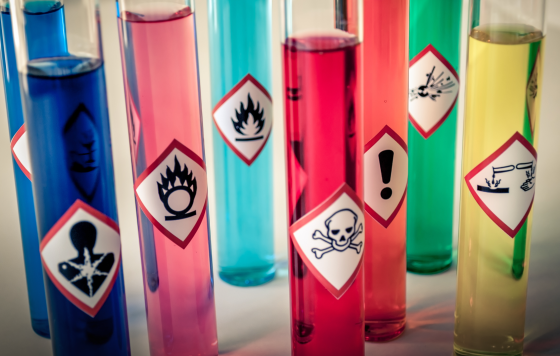
Artificial or synthetic turf is finding its way onto more athletic fields and playgrounds, but it is not without controversy and real concerns of safety. When comparing natural grass to artificial turf, Clean Water Action believes the evidence is clear --- natural grass is a better and safer option for both people and the environment.
What is synthetic turf?
Synthetic or artificial turf is made up of several layers, including plastic grass blades, plastic backing that holds the blades in place, and infill that provides cushioning, weighs down the turf, and helps the blades stand upright. Until recently, all infill was made with recycled ground up tires called “crumb rubber”.
Artificial turf contains hundreds of harmful chemicals like lead, heavy metals, benzene, arsenic, Volatile Organic Compounds (VOCs), PFAS, and phthalates, some of which are cancer-causing (carcinogens), neurotoxins, and/or endocrine disruptors. Even new “safer” alternatives for the turf infill contain carcinogens and neurotoxins (e.g., lead, PAHs). Unfortunately, there are gaps in what we know about synthetic turf because manufacturers are not required by law to reveal all of the chemicals used.
The grass blades and backing in synthetic turf is made with the use of PFAS (known as “forever chemicals”). PFAS chemicals are endocrine (hormone) disruptors and linked to decreased sperm count, as well as increased rates of infertility, risk of cancer, immune disorders, and more. Some manufacturers claim that their artificial turf is now PFAS-free, but this has not been supported by research.
Children and athletes are most vulnerable as they play on these surfaces, breathe in, absorb through the skin, and even ingest turf dust, microplastics, and corresponding toxic chemicals. This is especially worrisome with indoor synthetic turf, as high levels of toxins are found to outgas within half an hour of air sampling (p 47-49).
One scientific review of synthetic turf research found that in 14 studies that tested for lead, including a virgin rubber sample – all contained lead, with the levels varying between playing fields. According to the U.S. Centers for Disease Control and Prevention, there is no safe blood lead level.
Outdoor artificial turf has its own problems. It can get moldy over time and experience a buildup of animal/bird feces and related harms, thus requiring ongoing disinfection. This type of turf can also reach dangerous temperatures of over 160o F in the summer sun, while natural grass rarely exceeds 100o F. Kids have complained of skin burns and extreme heat penetrating their athletic shoes.
Plastic: Key Turf Ingredient and Global Contaminant
What is put on the field does not stay on the field. Synthetic turf breaks down into smaller pieces, including microplastics (less than 5 mm). They are carried long distances by the wind, leach into water systems, storm drains, and contaminate the soil. Barcelona, Spain found that artificial grass fibers “accounted for 15% of plastic pieces larger than 5 m within 1 kilometer from the shore.”
Additionally, synthetic turf only lasts about eight to ten years. According to the Synthetic Turf Council, the average athletic field uses 400,000 pounds of infill and 40,000 pounds of artificial turf carpet. There is no known way to recycle artificial turf so this product is piling up, buried or burned, contaminating the environment.
Growing Opposition to Synthetic Turf is Very Real
Due to both environmental and health concerns, towns in several states (including Boston, MA) have banned new synthetic turf fields. Others like Scotch Plains and Westfield, NJ held a local vote and rejected proposals to install synthetic turf.
The NFL Players Association asked to only play on natural grass, stating that artificial turf causes “unnecessary injuries”, especially non-contact injuries of the legs (e.g., meniscus tears) and abrasion burns (“turf burns”). The FIFA World Cup Soccer association and US national soccer teams always require grass playing fields.
Real grass playing fields are safer for humans, wildlife and the environment. Few, if any, chemicals are needed if field maintenance crews utilize Integrated Pest Management (IPM) techniques or organic lawn care, which is even better.
Natural grass has the added benefit of mitigating climate change. It has a cooling effect, oxygenates the air, captures carbon, and absorbs water more readily, which helps to reduce flooding and stormwater runoff.
If you can’t avoid artificial turf, here are some tips for playing safer and reducing your exposure to turf-related toxic chemicals.
- Avoid playing on synthetic turf on very hot days
- Always wear shoes on synthetic turf
- Wash hands before eating, drinking, or adjusting mouth guards
- Avoid using it for passive activities such as sitting, lounging, and picnicking
- Ensure good ventilation of indoor fields by opening doors and windows and using fans
- Monitor young children to prevent accidental ingestion
- Clean any cuts and abrasions with soap and water
- Brush hair thoroughly after play
- Shake out sports equipment and clothes outside or over the garbage
- At home, take off shoes before entering to avoid tracking in crumb rubber
- Shower immediately after playing on artificial turf
- Vacuum any infill that comes into your home
NOTE: All of the above concerns and tips also apply to playgrounds with rubber or recycled tire mulch. Best practice would be to utilize wood chips in place of rubber mulch.
Additional Resources
Icahn School of Medicine at Mt Sinai researchers have extensively studied and written about artificial turf, with a focus on the impact on children’s health.
The Partnership for Healthy Playing Surfaces, an excellent resource for information on synthetic turf.
Environment and Human Health, Inc. has written a careful analysis comparing synthetic turf industry claims versus what studies actually show regarding the chemicals in synthetic turf.


